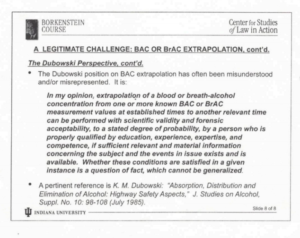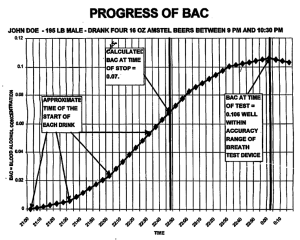Retrograde Extrapolation in DUI cases
Retrograde Extrapolation in DUI cases
What is retrograde extrapolation?
Retrograde Extrapolation in DUI cases is a very inexact method in science. It is the method of using existing known details to retroactively in time estimate what a blood alcohol level was at a specific time in the past.
As stated above by one of the eminent experts in alcohol issues, Dr. Dubowski has stated that retrograde extrapolation can only be accurate when done “by a person who is properly qualified by education, experience, expertise, and competence, if sufficient relevant and material information concerning the subject and the events in issue exists and is available. Whether these conditions are satisfied in a given instance is a question of fact, which cannot be generalized.”
How is retrograde extrapolation in DUI cases used?
Retrograde extrapolation is used mainly by the prosecution in a DUI case to guess, using whatever data points exist after the fact, what the blood alcohol level for a particular person was at the time of driving. Because the time of driving is the only relevant time where the alcohol level matters, a prosecutor has to show that a person was either impaired, or above a certain alcohol level, at that time. It’s not illegal to be drunk, or even a high blood alcohol level, in a private space (like a police station), only when driving a motor vehicle.
Even more speculatively, the prosecution sometimes uses retrograde extrapolation to estimate the amount of drinks that the driver or defendant had before getting in the car.
What are the problems with retrograde extrapolation in DUI cases?
As you might expect, estimating blood alcohol levels depend on a number of variables, and each of those variables have their own measurement problems, and margins of error.
In the human body, blood alcohol levels do not rise and fall in a steady fashion, but instead demonstrate (through scientific testing studies), spikes or steeping of the curve towards and away from peak alcohol levels.
In the downward part of the curve, returning back to sobriety, blood alcohol elimination is often assumed to be an average of 0.015 percent per hour. However, scientific studies show great variance in the general population from 0.008 to 0.030 percent per hour, and may vary even more than that in certain individuals.
Retrograde Extrapolation in DUI cases – Factors affecting results
Experts estimating retrograde extrapolation may not have all the information they need to make an accurate calculation. A proper estimation, at least, would have to have all the factors below:
- The person at issue must be in the post peak (dissipation) of alcohol. That requires that the timing of each drink is known.
- The calculation must know the person’s gender.
- We have to know the person’s weight at the time of driving.
- The calculation has to know the person’s lean body mass (to obtain the volume of distribution information).
- You must know the person’s age.
- The calculation should factor for the person’s true height.
- The calculations performed must account for the person’s mental state.
- The expert must know the type of alcohol that was introduced into the body.
- The calculation must account for the amount of food that is in the person’s stomach, and the timing of eating, before or after drinking.
- We have to know the type of food in the person’s stomach.
- The expert should know the starting time of the drinking episode.
- The calculation should account for the ending time of the drinking episode.
- The math must account for pace of the drinking episode.
- The retrograde extrapolation should know whether the drinks consumed were carbonated or not;
- The calculations done should account for the timing between last drink and time of breath test.
- The expert should know the number of samples taken, and the timing of each.
- The model used in calculation must know the latest time of any driving.
- The calculation should, but in almost every case doesn’t know, the particular absorptive rate for this person.
- The calculation should, but in almost every case doesn’t know, the particular elimination rate for this person.
- The expert should know of the existence of any sort of gastro-intestinal or other diseases or conditions (lap band, GERD, acid reflux, diverticulitis or interactions with any drugs used by the person).
As you can see, the calculation is complicated. Using retrograde extrapolation to estimate a defendant’s BAC at the time of driving has been criticized by many experts in the field. This method requires the toxicologist to make a number of assumptions; namely that the alcohol was completely absorbed at the time of testing, that the elimination of alcohol in the DUI suspect occurred at the “average” rate and that the driver’s blood-alcohol curve can be charted with accuracy.
When does the defense contradict retrograde extrapolation in DUI cases?
During the pretrial stage of a case, before trial, the defense can present any reports from forensic alcohol expert witnesses experienced with DUI cases as part of the negotiations towards a plea bargain with the prosecutor. That may end up in a dismissal of DUI charges, reduction of charges below a DUI, or plea bargain in the DUI case.
At trial, any retrograde extrapolation done by the defense expert witness in a DUI case can also be presented to the jury. Because the prosecutor cannot interview the DUI defendant and get all the factors above, the defense retrograde extrapolation has to be more accurate than the defense’s calculations.
Contact us
Contact us today for questions about retrograde extrapolation in DUI cases. We can help.




